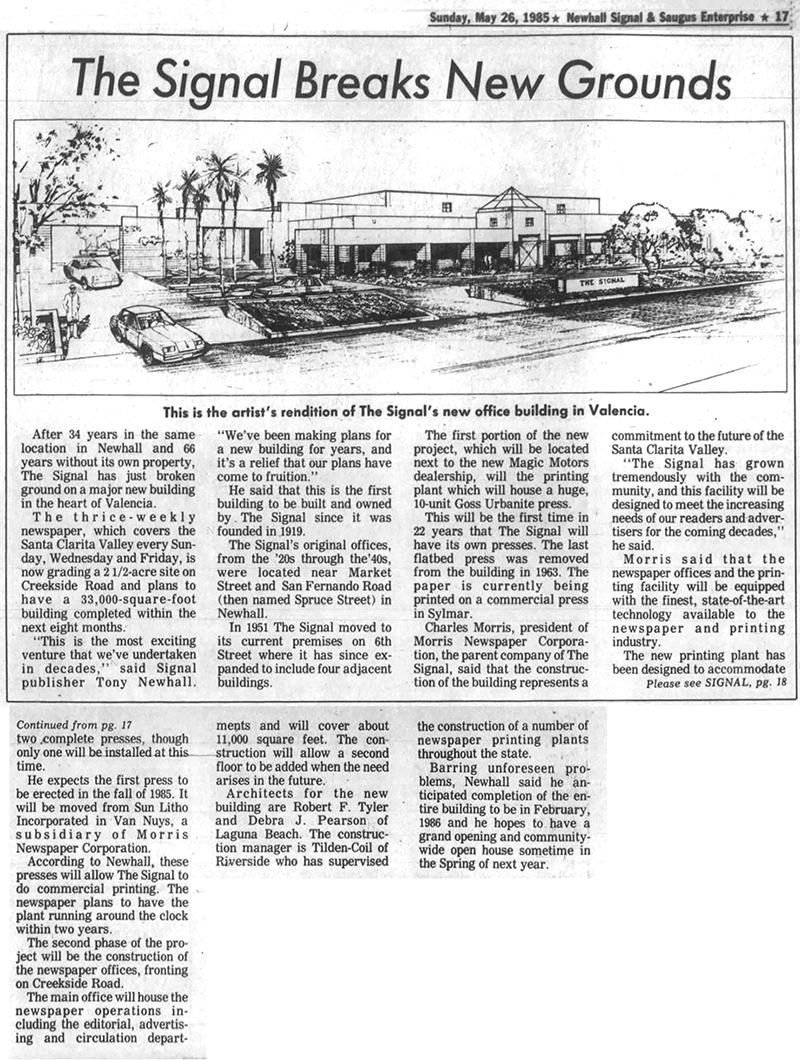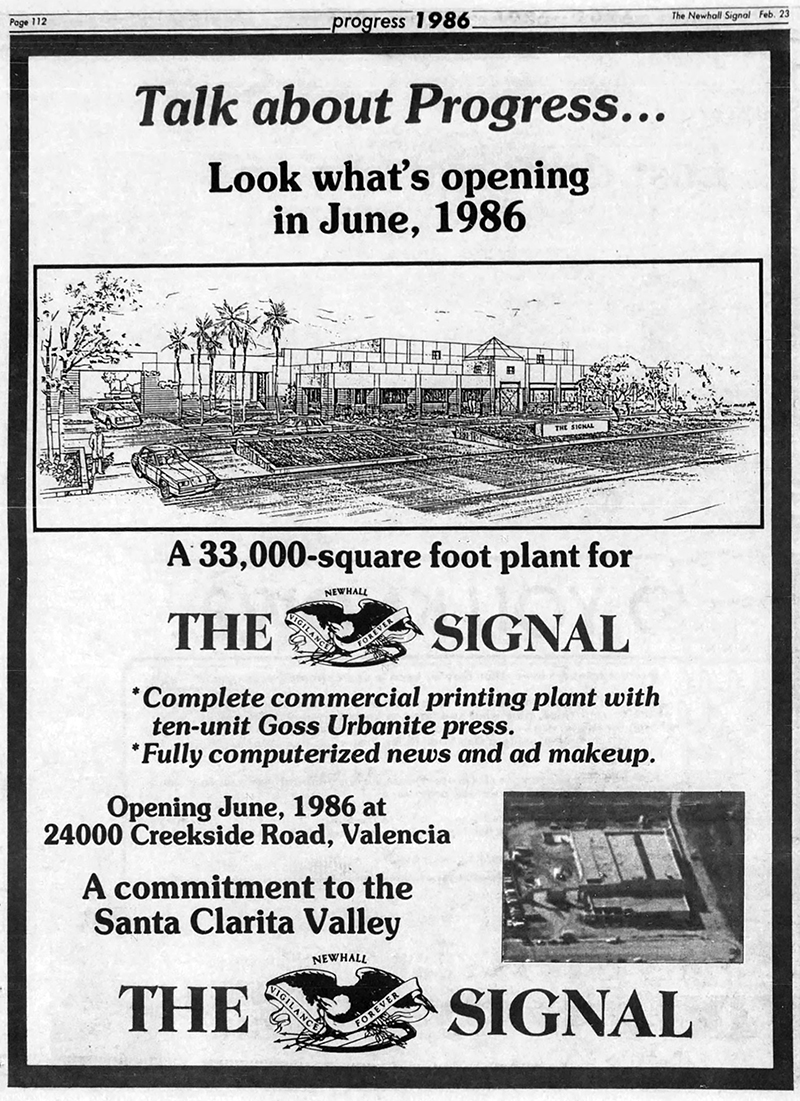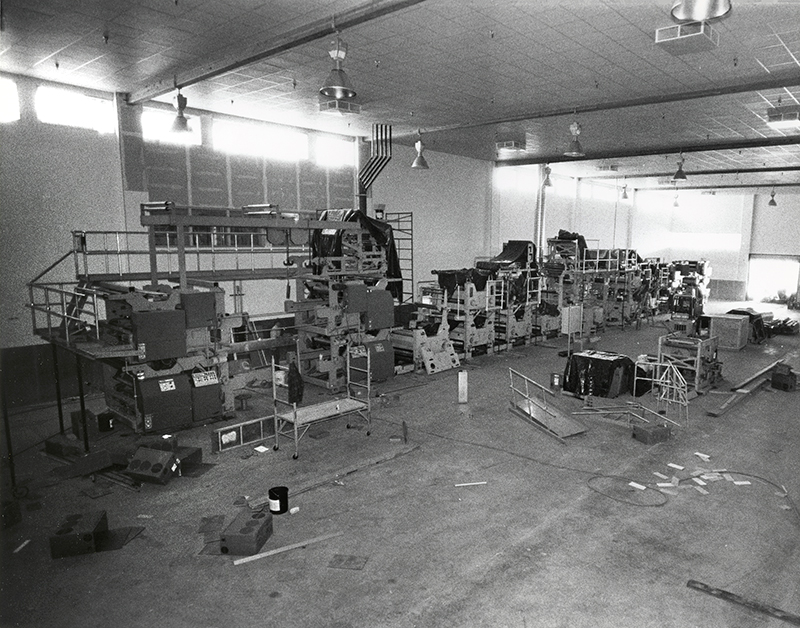|
The Signal's 10-unit Goss Urbante printing press is being assembled in the press room warehouse building at 24000 Creekside Road in Valencia in late 1985 or early 1986.
New to The Signal, the printing press was brought over from Sun Litho in Van Nuys, a printing house owned by Morris Newspaper Corp., then-owner of The Signal.
According to Morris Corp. president Charles Morris, quoted in
a May 1985 Signal story (below), initial plans called for the installation of two presses so the facility would be humming 24/7 with contract print jobs. However, a second press was never
installed, and The Signal didn't have as many print jobs as anticipated — although it did print the Fillmore Gazette and the Hart High Smoke Signal, among other things.
Neither was a second story built above the newspaper offices fronting Creekside, despite being engineered to bear the weight of a second floor.
The Signal opened in its new location September 8, 1986.
Morris sold the paper effective January 1, 2016. After 37 years, he owned it longer than anyone — by far.
Photo courtesy of then-publisher Tony Newhall.

Click to enlarge.
Signal Breaks New Grounds.
The Signal | Sunday, May 26, 1985.
After 34 years in the same location in Newhall and 66 years without its own property, The Signal has just broken ground on a major new building in the heart of Valencia.
The thrice-weekly newspaper, which covers the Santa Clarita Valley every Sunday, Wednesday and Friday, is now grading a 2½-acre site on Creekside Road and plans to have a 33,000-square-foot building completed within the next eight months.
"This is the most exciting venture that we've undertaken in decades," said Signal publisher Tony Newhall.
"We've been making plans for a new building for years, and it's a relief that our plans have come to fruition."
He said that this is the first building to be built and owned by The Signal since it was founded in 1919.
The Signal's original offices, from the '20s through the '40s, were located near Market Street and San Fernando Road (then named Spruce Street) in Newhall.
In 1951, The Signal moved to its current premises on 6th Street where it has since expanded to include four adjacent buildings.
The first portion of the new project, which will be located next to the new Magic Motors dealership, will the printing plant which will house a huge, 10-unit Goss Urbanite press.
This will be the first time in 22 years that The Signal will have its own presses. The last flatbed press was removed from the building in 1963. The paper is currently being printed on a commercial press in Sylmar.
Charles Morris, president of Morris Newspaper Corporation, the parent company of The Signal, said that the construction of the building represents a commitment to the future of the Santa Clarita Valley.
"The Signal has grown tremendously with the community, and this facility will be designed to meet the increasing needs of our readers and advertisers for the coming decades," he said.
Morris said that the newspaper offices and the printing facility will be equipped with the finest state-of-the-art technology available to the newspaper and printing industry.
The new printing plant has been designed to accommodate two complete presses, though only one will be installed at this time.
He expects the first press to be erected in the fall of 1985. It will be moved from Sun Litho Incorporated in Van Nuys, a subsidiary of Morris Newspaper Corporation.
According to Newhall, these presses will allow The Signal to do commercial printing. The newspaper plans to have the plant running around the clock within two years.
The second phase of the project will be the construction of the newspaper offices, fronting on Creekside Road.
The main office will house the newspaper operations including the editorial, advertising and circulation departments and will cover about 11,000 square feet. The construction will allow a second floor to be added when the need arises in the future.
Architects for the new building are Robert F. Tyler and Debra J. Pearson of Laguna Beach. The construction manager is Tilden-Coil of Riverside who has supervised the construction of a number of newspaper printing plants throughout the state.
Barring unforeseen problems, Newhall said he anticipated completion of the entire building to be in February 1986, and he hopes to have a grand opening and community-wide open house sometime in the Spring of next year.

Click to enlarge.
The Newhall Signal newspaper published weekly beginning February 7, 1919, operating out of an office in downtown Newhall, the valley's central business district. Then came Valencia, starting with the Old Orchard Shopping Center and Valencia Country Club ("Big V" golf course) in 1965, and the community's economic gravity began to shift.
The county courthouse left downtown Newhall in 1970 for a brand-new Civic Center at Valencia Boulevard and Magic Mountain Parkway, the latter named for a new theme park that was built to attract home buyers to new subdivisions that were replacing farmland. The Sheriff Station left in 1972, and the auto dealers weren't far behind. Both Magic Ford and Vince Wiese Chevrolet — two of the newspaper's biggest advertisers — left downtown Newhall to start a new auto mall that gave them closer proximity to a new, "young urban professional" customer base, and room to grow. Another big advertiser, Safeway, was long gone from the downtown, having left in 1965 to become an anchor tenant at Old Orchard, and new grocery stores were popping up with each new neighborhood shopping center — farther and farther away from the old business district.
The Signal grew with Valencia and eventually joined in the move. Scott Newhall, a shareholder in what was initially a family-owned company that developed Valencia, had purchased The Signal in 1963 and added a Sunday edition Dec. 5, 1965. He soon added a third day and expanded into the old Sheriff substation at 6th and (now) Main Street when it became available.
Then came the 1980s, and the population exploded from one end of the valley to the other. The Signal needed to expand to daily service, but to do that, it needed more space, a modern printing press, and better access to its advertisers.
The Newhalls had sold the paper in 1978 to Morris Newspaper Corp., a family-owned syndicate headed by Charles Morris, but the sale was transparent to the public because Newhall family members remained at the helm as editors and publishers. In the mid-1980s the company purchased vacant land at 24000 Creekside Road, literally down the street from the paper's major car-dealer advertisers and a stone's throw from a promised indoor shopping mall (which finally came in 1992). In 1985-1986 Morris erected an enormous tilt-up building which, at 35,892 square feet, could accommodate a car dealership if the time ever came to sell it. A gently used Goss Urbanite press — brought in from Sun Litho, a Morris-owned printing plant in Van Nuys — filled one of three warehouse spaces, while a second held rolls of newsprint and the third was dedicated to insertion and bundling for delivery.
The new building was dedicated to Scott Newhall, who steered the ship until 1988, and all operations remained in-house for the next 25 years, just as they had done in days of old.
| 
